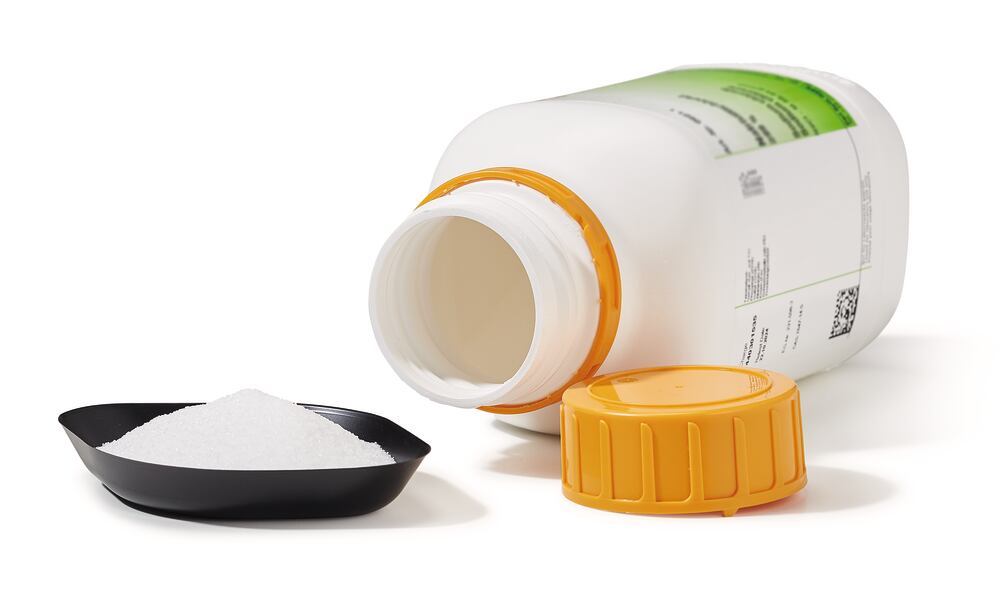Technical Data Sheet
Calcium oxide, 5 kg
≥96 %, extra pure
H315-H318-H335
causes skin irritation, causes serious eye damage, may cause respiratory irritation
P261 P280 P305+P351+P338 P310
avoid breathing dust, wear protective gloves/eye protection, IF IN EYES: Rinse cautiously with water for several minutes. Remove contact lenses, if present and easy to do. Continue rinsing, immediately call a POISON CENTER/doctor
Pack Qty.
Pack.
Lime caustic, Quicklime
Empirical formula CaO
Molar mass (M) 56,08 g/mol
Density (D) 3,37 g/cm³
Boiling point (bp) 2850 °C
Melting point (mp) 2572 °C
ADR 8
WGK 1
CAS No. 1305-78-8
EG-Nr. 215-138-9
UN-Nr. 1910
Molar mass (M) 56,08 g/mol
Density (D) 3,37 g/cm³
Boiling point (bp) 2850 °C
Melting point (mp) 2572 °C
ADR 8
WGK 1
CAS No. 1305-78-8
EG-Nr. 215-138-9
UN-Nr. 1910
€107.40/Pack Qty.
excl. VAT. | 5 kg per Pack Qty.
Art. No. CN88.3
In stock
Delivery fast, simple and reliable!
from 6 Pack Qty.
€102.03/Pack Qty.
from 24 Pack Qty.
€96.66/Pack Qty.
Add to shopping basket
Product details
Calcium oxide ≥96 %, extra pure
Technical Information
| Suitable (as desiccant) for | Ammonia, amines, alcohols, nitrous oxide, ether |
| Not suitable (as desiccant) for | Acids, acid derivatives, aldehydes, ketones, ester |
| Particle size |
D50 ca. 20 µm D90 ca. 65 µm |
| Regeneration | 1000 °C |
Add to shopping basket
Calcium oxide
Selected quantity:
0
- Subtotal: 0.00
Add to shopping basket
| Art. No. | Pack Qty. | Pack. | Price | Quantity | |
|---|---|---|---|---|---|
| CN88.1 | 500 g | plastic |
€19.90 |
|
|
| CN88.2 | 1 kg | plastic |
€31.75 |
|
|
| CN88.3 | 5 kg | plastic |
€107.40 |
|
|
| CN88.4 | 2.5 kg | plastic |
€60.10 |
|
|
|
In stock
Available
In procurement
No longer available
Delivery date currently unknown
|
|||||
Selected quantity:
0
- Subtotal: 0.00
Add to shopping basket
Downloads / MSDS
General information
Desiccants
Desiccants can absorb water and bind it chemically (reversibly or irreversibly) or physically. The main desiccants can be subdivided into four categories:
- non-renewable chemical desiccants
- renewable chemical desiccants
- silica gels
- molecular sieves
Drying methods for solvents
| Solvent | Molecular sieve |
Potassium carbonate |
Calcium chloride |
Phosphous pentoxide |
| Acetic acid | - | - | - | + |
| Acetic acid anhydride | - | - | + | - |
| Acetic acid ethyl ester | 4 Å | + | - | + |
| Acetic acid methyl ester | 4 Å | + | - | + |
| Acetone | 3 Å | + | + | - |
| Acetonitrile | 3 Å | + | + | + |
| Benzene | 4 Å | - | + | - |
| 1-Butanol | - | + | - | - |
| 2-Butanol | - | + | - | - |
| 1-Butanone | - | + | + | - |
| Chloroform | 4 Å | - | + | + |
| Cyclohexane | 4 Å | - | - | - |
| Dichloremethane | 4 Å | - | - | - |
| Diethylether | 4 Å | - | + | - |
| Diisopropyl ether | 4 Å | - | + | - |
| Dimethyl formamide | 4 Å | - | - | - |
| Dioxan | 4 Å | - | + | - |
| Ethanol | 3 Å | - | - | - |
| Ethyle formate | - | - | + | - |
| n-Hexane | 4 Å | - | - | - |
| Methanol | 3 Å | - | + | - |
| 2-Propanol | 3 Å | - | - | - |
| Pyridine | 4 Å | - | - | - |
| Tetrahydrofurane | 4 Å | - | + | - |
| Toluene | 4 Å | - | + | - |
| Trichloroethylene | - | + | - | - |
| Xylene (Isomer compound) | 4 Å | - | + | - |
Certificates of Analysis
Type analysis
| Assay | 95.0-100.5 % |
| In HCl insoluble matter | ≤1.0 % |
| Loss on ignition | ≤10.0 % |
| Fluoride (F) | ≤0.005 % |
| Arsenic (As) | ≤0.0003 % |
| Lead (Pb) | ≤0.0002 % |
| Barium (Ba) | ≤0.03 % |
| Iron (Fe) | ≤0.05 % |
| Mg and alkali salts | ≤3.6 % |
| Water | ≤1.0 % |
| Particle size d50 | ca. 20 µm |

